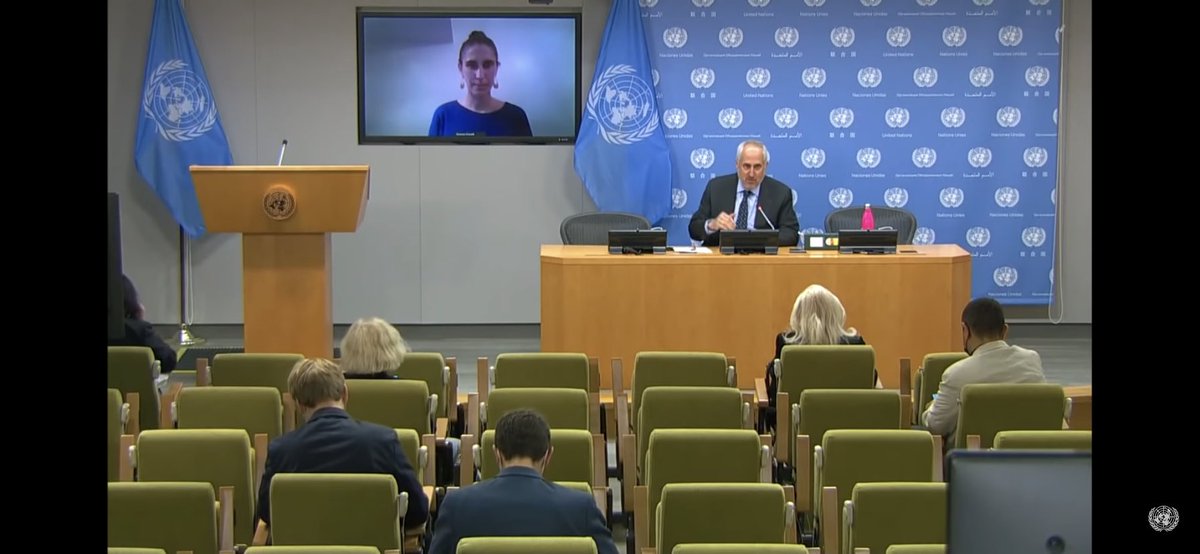
This special OCHA press briefing was not carried live on UN Web TV and was posted to @youtube early this morning CEST, around midnight ET(US).
It was held before the regular press briefing which I posted last night, and explains why that was light on Ethiopia content.


It was held before the regular press briefing which I posted last night, and explains why that was light on Ethiopia content.
https://twitter.com/althecat/status/1451779092441968641



In the intro @UN_Spokesperson @StephDujarric jokes that he arranged the briefing as there is lots of media questions, and also because “I didn’t want to answer them”.
The briefing is from the OCHA regional coordinator Gemma Connell, based in Nairobi.


The briefing is from the OCHA regional coordinator Gemma Connell, based in Nairobi.



Here is the readout from Ms Connell, which was followed by a Q&A with three questions from reporters from @ap @reuters and @nytimes.
The aborted flight appears to have been the reason for increased media interest.

The aborted flight appears to have been the reason for increased media interest.


The first two questions were about fuel supply blockages, but neither of the questioners - @EdithLedererAP nor @michellenichols of @reuters - nor the @OCHA_Ethiopia’s Connell addressed the issue of fuel & trucks being diverted by the TPLF for its military use.
Q @EdithLedererAP: What is the OCHA’s assessment of why all the fuel trucks are being blocked?
A: We don’t have an assessment on that to be honest, all we know is that each day we reiterate that we need that fuel to deliver humanitarian aid.
A: We don’t have an assessment on that to be honest, all we know is that each day we reiterate that we need that fuel to deliver humanitarian aid.

Follow up from @EdithLedererAP: Can you make clear to us who is blocking the aid? The Govt, or Tigrayans?
A @OCHA_Ethiopia: There are a multiple of factors, approvals from Govt., checkpoints, and community resistance.
A @OCHA_Ethiopia: There are a multiple of factors, approvals from Govt., checkpoints, and community resistance.
Connell said community concerns (in Afar) are being raised on why so many trucks are going to Tigray. She emphasizes that OCHA has open lines of communication with the the Govt. and the Afar Govt. and says they are also engaging directly with communities on the ground.
Q @EdithLedererAP: On the flight to Mekelle, are you going to try again tomorrow or do you think that it is now too risky to fly aid in?
A: We are still assessing details of what happened… until we are able to fly safely we will have to look at what we are able to do.
A: We are still assessing details of what happened… until we are able to fly safely we will have to look at what we are able to do.
Next questioner, @michellenichols @reuters: Regarding malnutrition among those in the affected regions. “What visuals are you seeing of how desperate the situation is?” 

A: One of the biggest challenges we are facing in terms of addressing that issue is the lack of fuel. Without fuel the teams that do community screening of child malnutrition are unable to move.
… (continues): That said we are seeing malnutrition in urban areas among people who are able to move. Once we get out to rural areas the rates will be higher. This is what teams are telling us.
… (continues): This is extremely serious both for children and especially for pregnant and lactating women. Both for the children they are carrying and those they are feeding.
Q @michellenichols: I know you are in a difficult position to address what’s holding up fuel trucks. But on a basic level where do these trucks/fuel come from?
A: This is UN procured fuel waiting at the staging point in Semara. What we need is the green light to move. Without that our operations will come to a grinding halt in the not too distant future.
Final questioner is @rickgladstone from the @nytimes.
Q: On the aborted flight. Can you elaborate on the cargo? We know there were 11 people on it. Who were they, and is this the first UN flight aborted on a trip to Mekelle?
Q: On the aborted flight. Can you elaborate on the cargo? We know there were 11 people on it. Who were they, and is this the first UN flight aborted on a trip to Mekelle?

A: The 11 people were humanitarian personnel, I won’t go into detail about them. We have had flights turn around because of weather but this is the first to turnaround due to air strikes on the ground in Ethiopia. 

And that’s a wrap:
In conclusion @StephDujarric thanks Gemma Connell for briefing on short notice and says he hopes she will be back for more briefings.
To which I add my thanks and hopes for more briefings also. And more questions.
In conclusion @StephDujarric thanks Gemma Connell for briefing on short notice and says he hopes she will be back for more briefings.
To which I add my thanks and hopes for more briefings also. And more questions.
A detailed briefing on UN assessment of the conflict in the Amhara region and apparent threats made in the last two days by TPLF leadership to escalate their war on Amhara civilians is needed urgently.
/ENDS
/ENDS
@threadreaderapp unroll
• • •
Missing some Tweet in this thread? You can try to
force a refresh





